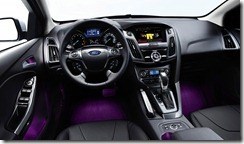Ford IDs 10 Changes in the Last 10 Years
Sheryl Connelly, Ford Motor’s global trends manager, has come out with an interesting, if not completely surprising, list of the 10 things that have changed in automobiles between 2000 and 2010 (and props to her for using that timeframe, as the decade seems to have been underutilized by list makers). Probably the biggest change is related to this observation that she makes: “Consumers today want to stay connected and they want the drive to be an experience, especially since the amount of time Americans spend in the car has nearly doubled in the last 10 years.” Meaning that 10 years ago they might have been satisfied listening to CDs and talking on a cell phone with sketchy coverage, but no more.
Sheryl Connelly, Ford Motor’s global trends manager, has come out with an interesting, if not completely surprising, list of the 10 things that have changed in automobiles between 2000 and 2010 (and props to her for using that timeframe, as the decade seems to have been underutilized by list makers).
Probably the biggest change is related to this observation that she makes: “Consumers today want to stay connected and they want the drive to be an experience, especially since the amount of time Americans spend in the car has nearly doubled in the last 10 years.”
Meaning that 10 years ago they might have been satisfied listening to CDs and talking on a cell phone with sketchy coverage, but no more. It might have been great to have audio and visual warnings about doors being ajar or lights being left on, but that’s insufficient. Technology is become far more pervasive.
Consequently, she starts her list (and know that in making her list she is—again not surprising—Ford-centric, but we’ll leave the Ford examples out, but know that Ford is well-entrenched in each of the categories, but they aren’t the only player in these spaces) as follows:

1. Infotainment. Voice-activated controls, real-time traffic, WiFi mobile hot spots—these are becoming more common—and expected. Ten years ago, no matter how extreme your language, you car didn’t listen.
2. Entertainment. Satellite radio. Streaming Internet radio. USB plug in music. iPods. 10 years ago, if you said “Satellite radio” to someone, they’d probably think about astronauts.
3. Simplified driving. Ten years ago, cars that could park themselves were the stuff of the Jetsons. And backing up any-sized vehicle with a rear-view camera surely makes things a whole lot nicer.
4. Safety/Accident avoidance. The number of airbags has proliferated. Stability control is standard. And there are things like blind-spot detection systems that help keep you where you need to be.
5. Fuel economy. It used to be if you had a big vehicle you had low miles per gallon. New tech—from direct injection to turbocharging—makes a big difference in mpgs.
6. Navigation. Whether it is built-in or something from Best Buy, the number of nav systems has skyrocketed.
7. Comfort. Heated seats are now found in even entry-level cars. And what vehicle manufacturer doesn’t tout the number of storage containers for beverages?
8. Customization. More vehicles now allow you to change the colors of the lighting in the footwell and around your cupholder. Ask yourself if you even thought about your footwell 10 years ago.
9. Security. Think not only of things like Ford SYNC’s 911 Assist or GM’s OnStar, but the fact that more cars are now featuring built-in remote alarm systems and fob-actuated door and trunk opening (with, for example, many key cylinders disappearing from trunks).
10. Paint. Nowadays, the sort of metallic paints that were once simply aftermarket are now selected right off the brochure (or screen) at the dealership.
While the cars of 2010 aren’t quite what one might have imagined, say, back in 1990 (“By 2010, cars will drive themselves, fly, and get 100 miles per gallon. . . .”), they’ve certainly advanced during the past decade.


.jpg;width=70;height=70;mode=crop)